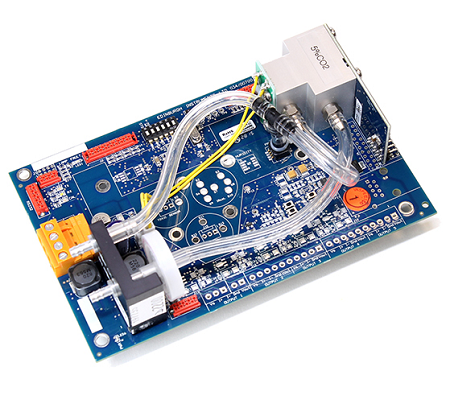Methods for water quality checking are an incredibly important part of the many processes involved in ensuring we have access to safe drinking water. However, as contaminants can come from many different sources, finding a general solution for contaminant identification and removal can be difficult.
Purification processes for water treatment include removal of undesirable chemicals, bacteria, solid waste and gases and can be very costly. Utility companies in England and Wales invested £2.1 billion between 2013 and 2014 into infrastructure and assorted costs to ensure safe drinking water.1
One of the most widely used measures for water quality checking in order to assess whether water is safe for consumption or not is the analysis of the organic carbon (TOC) content. Dissolved organic carbon content is a measure of how much carbon is found in the water as part of organic compounds, as opposed to inorganic sources such as carbon dioxide and carbonic acid salts.2 It has been a popular water quality checking method since the 1970s for both assessment of drinking water and checking wastewater has been sufficiently purified.
The proportion of organic carbon in water is a good proxy for water quality checking as high organic carbon levels indicate a high level of organisms in the water or, contamination by organic compounds such as herbicides and insecticides. High levels of microorganisms can arise for a variety of reasons but are often a sign of contamination from a wastewater source.
TOC for Water Quality Checking
Water therefore needs to be continually monitored for signs of change in the TOC content to check it is safe for consumption. While many countries do not specifically regulate for TOC levels, the concentrations of specific volatile organic compounds are covered by legislation and recommended levels of TOC are 0.05 ml/l or less.3
There are a variety of approaches for water quality checking using total organic carbon. One approach is to measure the entire carbon content (organic and inorganic) and then subtract any carbon dioxide detected (as it is considered inorganic carbon) and any other carbon from inorganic sources. Another is to use chemical oxidation or even high temperature so that all the organic compounds in the sample will be oxidized to carbon dioxide, and measuring the carbon dioxide levels, therefore, acts as a proxy for the TOC concentration.
For wastewater plants, being able to perform online, real-time analysis of water content is key and measurements must be sensitive and accurate enough to pick up small changes in even low concentrations of chemical species. UK legislation also makes it an offense to supply drinking water which does not adhere to legislation4, with several water suppliers being fined over a hundred million pounds for recent discharges of contaminated waters.5
Vigilant Monitors
One of the advantages of using carbon dioxide levels as a proxy for TOC content is that carbon dioxide absorbs infrared light very strongly. This means using nondispersive infrared (NDIR) detectors provide a very sensitive way of detecting even trace amounts of carbon dioxide.
Edinburgh Sensors are one of the world leaders in NDIR sensor production and offer a range of NDIR-based gas detectors suitable for TOC measurements of water.6 Of these, for easy, quick and reliable TOC measurements, the Gascard NG is an excellent device for quantifying carbon dioxide levels.7
Gascard NG for Water Quality Checking
The Gascard NG is well-suited to water quality checking via continual carbon dioxide monitoring for several reasons. First, the device is capable of detecting a wide range of carbon dioxide concentrations, from 0 – 5000 ppm, maintaining a ± 2 % accuracy over the full detection range. This is important so that the sensor has the sensitivity required for checking TOC levels are sufficiently low to be safe for drinking water but means it is also capable of operating under conditions where TOC levels may be very high, for example in the wastewater purification process.
As it can come with built-in true RS232 communications for both control and data logging, the Gascard NG can be used to constantly monitor carbon dioxide levels as well as be integrated into feedback systems, such as for water purification, to change treatment approaches if the TOC content gets too high. UK legislation also requires some level of record-keeping for water quality levels, which can also be automated in a straightforward way with the Gascard.4

The Gascard NG is capable of self-correcting measurements over a range of humidity conditions (0 – 95 %) and the readings can be pressure-corrected with on-board electronics between 800 to 1150 mbar. Temperature compensation is also featured between 0 to 45ºC to ensure reliable measurements, over a wide range of environmental conditions.
Designed to be robust, maintenance-free and fail-safe, the Gascard NG also comes with several customizable options. The expansion port can be used for small graphical display modules for in-situ observable readings and TCP/IP communications can also be included if it’s necessary to have communications over standard networks. In conjunction with Edinburgh Sensor’s expertise and pre- and post-sales support, this means that the Gascard NG can easily be integrated into existing TOC measurement systems to ensure fast and accurate monitoring at all times.
Get in touch
If you have enjoyed reading about total organic carbon content measuring for water quality checking and would like to read more from Edinburgh Instruments, sign up to our newsletter and follow us on social media! If you are interested in any of our products which are idea for water quality checking, why not contact us today?
References and Further Reading
- Water and Treated Water (2019), https://www.gov.uk/government/publications/water-and-treated-water/water-and-treated-water
- Volk, C., Wood, L., Johnson, B., Robinson, J., Zhu, H. W., & Kaplan, L. (2002). Monitoring dissolved organic carbon in surface and drinking waters. Journal of Environmental Monitoring, 4(1), 43–47. https://doi.org/10.1039/b107768f
- DEFRA (2019) http://dwi.defra.gov.uk/consumers/advice-leaflets/standards.pdf
- Water Legislation (2019), http://www.legislation.gov.uk/wsi/2018/647/made
- Water Companies Watchdog (2019) https://www.theguardian.com/business/2019/jul/10/watchdog-tells-water-companies-england-clean-up-act
- Edinburgh Sensors (2019), https://edinburghsensors.com/about/about-us/
- Gascard NG, (2019), https://edinburghsensors.com/products/oem/gascard-ng/

